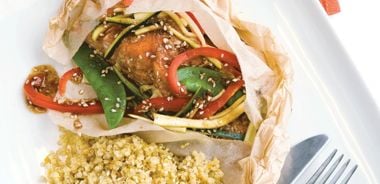Sesame Salmon with Orange-Scented Quinoa

Green pick
Farmed salmon is rife with problems, including polluting surrounding waterways and crowding out wild stocks when escapes occur. During the summer months more sustainable wild salmon can be found at the fishmonger for a price that is a little more amicable to your wallet. Most discerning palates consider the flavour and texture of wild fish to be markedly superior to that of farmed.
Health perk
Like Arctic char, wild salmon is loaded with protein and the two blockbuster omega-3s—DHA and EPA. The summer vegetables and fibre-rich whole grain quinoa up the health ante on this great meal.
Recipe note
Cooking fish in parchment-paper packets keeps it deliciously moist as it bakes in its own juices. Minimal cleanup also means more time to enjoy long summer nights. Recipe can be halved.
1 1/2 lb (750 g) wild salmon filets
3 Tbsp (45 mL) low-sodium soy sauce
2 Tbsp (30 mL) sesame oil
2 Tbsp (30 mL) rice wine
1 Tbsp (15 mL) grated fresh ginger
2 tsp (10 mL) honey
2 tsp (10 mL) sesame seeds
1 tsp (5 mL) Chinese five-spice powder
4 oz (100 g) sugar snap peas, ends trimmed
1 medium zucchini, julienne cut
1 red bell pepper, julienne cut
1 cup (250 mL) quinoa
Zest of 1 medium orange
In bowl, combine soy sauce, sesame oil, rice wine, ginger, honey, sesame seeds, and Chinese five-spice powder. Pour over salmon and marinate in refrigerator for 1 hour.
Preheat oven to 375 F (190 C). Cut 4 - 24 in (60 cm) pieces of parchment paper and fold in half crosswise. Draw a half heart, with the centre of heart on the fold line, and then cut out the shape. Open it up and place salmon on one side of each heart, fairly close to crease. Top salmon with vegetables and drizzle leftover marinade on top.
Starting at the top, seal the packet by folding edges together in a series of small, tight folds. Twist the tip of the packet and tuck it underneath. Place packets on baking sheet and cook for 20 minutes.
Meanwhile, in saucepan combine quinoa, orange zest, and 2 cups (500 mL) water. Bring to a boil and then simmer until water is absorbed, about 10 minutes. Allow packets to rest for 5 minutes before carefully opening, and serve with quinoa.
Each serving contains: 520 calories; 45 g protein; 20 g total fat (4 g sat. fat, 0g trans fat); 38 g carbohydrates; 5 g fibre; 488 mg sodium
source: "Great Catch!", alive #332, June 2010





